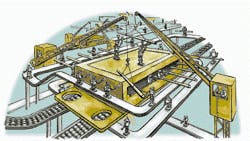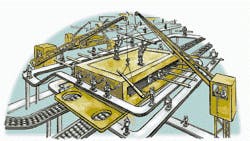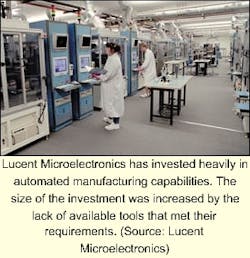Component shortages change investment strategies
With supply falling further behind demand, companies are now investing more in manufacturability, including automated techniques.
By Stephen HardyEditorial Director and Associate PublisherThe explosion in demand for optical technology means smiles all around for the fiber-optics community. Well, al most all the way around-for the euphoria racing through the sales and marketing departments in most optical component companies as orders reach record highs may very well be matched by growing consternation in the offices of operations managers. For these poor souls, too much is indeed not enough, at least when it comes to manufacturing capacity; it seems that new production facilities become inadequate almost before they are completed.
For many companies, the answer lies in attempting to automate production processes that have traditionally relied on dozens of workers peering through magnification devices in hopes of properly assembling complex components by hand. However, despite advances in other industries, optical component manufacturers have discovered that even automation can be a hand-tooled process.
The value of a vibrant optical component endeavor has never been more apparent-or better recognized, judging from recent moves by some of the giants in the industry. Nortel Networks (Brampton, Ontario) has focused its efforts in this area into a new business unit, High Performance Optical Components Solutions. The group will comprise activities in Harlow and Paignton, UK; Ottawa, Ontario; and Research Triangle Park, NC. Most recently, Lucent announced it would spin out its Microelectronics Group (Allentown, PA) into a separate company to better position it to supply optoelectronic components to the industry at large (see Lightwave, September 2000, page 35).Both companies have shown a willingness to invest in manufacturing as part of this new focus. This year alone, for example, Lucent Technologies Microelectronics Group (Allentown, PA) announced a $40-million upgrade to the manufacturing facilities it gained as part of the Ortel acquisition as well as a $30-million expansion of several of its previously existing capacities, including a new 143,000-sq-ft building in Breinigsville, PA, and an enhancement of the nearby Reading facility. Lucent expected the investment to quadruple its output this year. Nortel Networks opened a new production line in Monkstown, Northern Ireland, as part of a $400-million outlay for optical technology expansion announced last November. The company now says it will invest a total of $660 million to triple production of what it calls "Optical Internet solutions."
Not to be outdone, JDS Uniphase (Nepean, Ontario, and San Jose, CA) has been adding capacity through acquisition (although the Justice Department ordered it to release the hold E-TEK had on certain third-party manufacturing capacity-see Lightwave, August 2000, page 39).
But companies across the component community have begun to recognize that merely adding more chairs for assemblers will continue to prove inadequate to meet current and future demand. Therefore, many have investigated automating at least part of their manufacturing processes.
Lucent's experience represents one of the more advanced examples. The company opened its automated Manufacturing Resource Center in Breinigsville to reporters in May. The facility boasts a series of bonding, testing, and sorting stations, each housed in a self-contained miniature cleanroom. Each station performs one or more functions necessary to the construction of specially designed optical subassemblies and the components of which they are a part. Under the watchful eye of a technician, each station handled as many as 50 components at a time, housed in waffle packs that runners shuttled from station to station. The use of the generic optical subassemblies-designed with automated manufacturing in mind-allows a station to support the production of several product lines.
But this degree of production sophistication didn't come easily. Lucent had to design and develop these stations because the machines the company required to meet its needs weren't available from outside suppliers.
Other companies besides Lucent have attempted to add automation to their production processes. For example, Corning Inc. (Corning, NY) had a big order for components that clearly required a rethinking of current manufacturing capacity. According to Windsor Thomas, pro duct-line manager for DWDM components at Corning, "There are two basic approaches you can go with. One of them is the brute-force method, which is, 'I'm going to do what everybody else is doing, and just go on out there and build as fast as I can.' The other one is, 'what [angle] do I have into this so that I can do things differently so that I can bring more quality capacity to bear faster than the way other people are doing it, and more cost-effectively?'"
Corning chose to turn to outside expertise, in the form of a company with which they already had established a relationship. Corning teamed with Samsung Electronics (Seoul, Korea) to create an equity venture company called Samsung Corning Micro-Optics that would use Samsung's automated manufacturing expertise to produce components for DWDM applications and erbium-doped fiber amplifiers based on Corning technology. The two companies announced the joint venture last February; four months later, they announced a $110-million expansion plan.
The automation expertise focuses on three processes-precision alignment, adhesive delivery, and soldering. For example, the facility uses vision systems and robotics to align pieces such as the thin-film filter to the filter holder and the collimator. The adhesive delivery provides the exact amount of adhesive necessary to prevent excess from spilling over into the optical layer. The soldering machines use optical power peaking measurements to align parts perfectly before they are attached.
As the developers at Lucent discovered, Corning and Samsung found few options when it came to existing automation equipment. "It is very true to say that there is no off-the-shelf automation equipment that today are directly transferable to the manufacturing of optical components," Thomas says. "If there were, then obviously it would be far more common. I can say that all of the equipment our joint venture has in place today is one-of-a-kind with unique IP [intellectual property] around it designed in-house."
Presently, the machines used in the joint venture have not been duplicated in other Corning facilities. However, as the company explores the "brute force" approach Thomas mentioned-it has announced a new $80-million facility in Henrietta, NY, a $270-million expansion of capacity for Corning Lasertron, a $50-million upgrade of its Erwin, NY, plant, the creation of a second optical amplifier manufacturing facility in Benton Township, PA, at a cost of another $50 million, and an increase in the capacity of its Marlborough, MA, thin-film-filter plant this year-Corning can be expected to look for ways of applying some of the lessons learned in Korea to its activities in the United States.
Applying lessons learned has proven essential for another components manufacturer, ADC Telecommunications Inc. (Minneapolis). Like others, ADC found little in the way of outside help when it came to automating its processes. "We pretty much had to go vertical on automating some of these processes because they quite honestly didn't exist anywhere else," explains Martin Nyman, a director of product management at ADC. The company has historically been a very vertically integrated manufacturer anyway, having worked to develop products for copper, wireless, and fiber applications. "We tend to know how to do things like that, so we've had to collectively figure it out as we go along," he adds.
Nyman says that certain areas lend themselves readily to automation. "Areas that will get attention would be things such as assembly, especially when you're getting to microassembly and alignment of fibers to devices. Testing is another area," he says. When companies focus their efforts on key areas, the hard work involved in bringing automation to the shop floor is well worth the trouble. "It enhances quality because you get a degree of consistency that's very good. Number two, it also addresses the throughput issue, if you have a long cycle time to the test. And lastly, it allows you the collection of data, which in any good manufacturing process, you need to understand the trends and the quality to make sure that if you have a critical parameter you're not going off the specification," he explains.
With such an obvious need for automated manufacturing equipment, it might seem perplexing that so many companies have yet to find a ready supplier. One company, Newport Corp. (Irvine, CA), is attempting to fill the gap. Newport has been providing scientific and precision equipment for more than 30 years, and has focused on the photonics and fiber-optics market for slightly less than a decade, says Dr. Kamran Mobarhan, marketing manager, technology and applications, for Newport's Fiber Optic and Photonic Div. The company recently announced its Advanced Manufacturing System series of products, which aim to optimize systems originally developed for research and development applications for manufacturing tasks.
"Our general philosophy and direction is to make our instruments suitable for high-volume production, but at the same time not make them useless for research activities. Because it is our belief that a lot of these research activities need to be manufacturable in a very short period of time," he explains. "People spend a lot of time developing new technologies and processes and techniques in their research labs. And once things work and they demonstrate that everything is fine, they have to launch it into manufacturing almost immediately. There is no time to go back and redesign a product to go from R&D to manufacturing. So we have noticed that a lot people who are doing research prefer to buy the same type of equipment for research that they're going to use in high-volume production. So we're trying to bridge this gap between R&D equipment and high-volume manufacturing equipment."
The series includes such systems as the LaserWeld family of automated packaging workstations (see Lightwave, August 2000, page 189) and the AutoAlign series of alignment, characterization, and bonding workstations. Newport announced the series in March and has recorded several sales, including one to Samsung.
Despite this success, Dr. Mobarhan readily acknowledges the frustrations of his potential clients. "It's true-there isn't much out there in terms of automation, because this industry is very new," he says. "I would say we are where semiconductor chip manufacturing was in the early '70s. It's only very recently, over the last couple years, that people are really looking for a vendor that can supply these automation systems." Dr. Mobarhan reports that customization therefore is very much the rule. Even when Newport can supply one of its systems, the user will frequently tinker with it to fit the machine properly into the role the customer has in mind.
Dr. Mobarhan says that such customization reflects that, like the chip industry in the 1970s, many optical component companies are blazing their own trails when it comes to developing products and manufacturing techniques. For this reason, these companies must shoulder some responsibility for the fact that there are few automated tools available. "It's such a new technology that everybody is designing their own package and going in their own direction. So there is really no standardization in the products that are coming out, which makes building automation systems that apply across the board to all these products very difficult," he explains.
While some standard form factors have been announced by industry consortia for certain products, wide-scale packaging standards remain in the future. (However, some companies, particularly those involved in wafer-based products such as lasers and planar lightwave circuits, are taking the semiconductor metaphor to heart by porting standard semiconductor processes to their applications.) Many companies interested in automated manufacturing have taken the interim step of designing their components with automated manufacturing in mind. As noted, Lucent developed its optical subassemblies to mesh with its new resources. Other companies have followed suit.
"We had the functionality of the device that we knew we had to meet. So we put our design optical engineers in a room with their automation experts and, as with any other design process, we did tradeoffs," relates Corning's Thomas. "At the end of the day, we agreed on a design for a high-performing DWDM module that they told us they could automate."
Says ADC's Nyman, "Early on, when you get thrust into a market, you're caught up in serving the demand, and you didn't necessarily have the time perhaps to take the time to tweak the design so that it would be a little bit easier in the manufacturing stage. More and more of the products we're developing now are done so with a member of our advanced manufacturing group involved." The company has worked closely in recent months with Newport along these lines.
Dr. Mobarhan sees this trend with other companies, as well. "Everybody is being pressed by the shorter time-to-market," he relates. "So, little by little, people are being forced to move toward simpler products that are standard, that are easier to make, that can be made in high volume. For the first time, really, the idea of designing a new technology with manufacturability in mind is growing."
The current market climate should promote an even greater increase in the desire for automated manufacturing. "At the same time that capacity requirements are shooting through the roof, performance improvements around such attributes as insertion loss, isolation, dispersion, PMD [polarization-mode dispersion] are also increasing at a very dramatic pace. So you're getting squeezed from both ends," says Thomas. "It means the cycle time is a fraction of what just a year or two ago would have been considered normal. Anyone that has a six-to-nine-month product-development cycle time is dead. If you're not cranking out new products with significant improvements every few months or so, you're not going to be able to keep up with the very few, very large players in components."
Manufacturability therefore be comes an increasingly important part of a company's skill set as it attempts to keep up with demand. "One of the things that challenges this industry is the fact that you've got a lot of companies who may have, by their heritage, been largely R&D-based companies. And they had all the intellectual capital necessary to design and develop these great new technologies-however, the manufacturing disciplines were the ones that were typically in short supply," says Nyman. "One thing that is absolutely helping tremendously is the fact that we're bring our MRP [materials resource planning] system into companies that we've acquired, such as, say, Altitun, and it's paying off in getting up the learning curve that much faster."
As these companies climb the learning curve, they should find more resources available to help them. "Right now, essentially what this industry is doing is making very fancy robots to make different types of sausages. You don't want to do that. You don't want to make fancy robots to make sausages. You want to design the sausages in a way that you can crank them out using a big sausage machine," Dr. Mobarhan concludes. "Little by little, we have to move away from designing very sophisticated machines to perform sophisticated tasks by making those tasks simpler, by breaking it up into different phases or departmentalizing the complex process to make it more manufacturable. And we're working with a lot of different people to achieve this end result."
Until the industry reaches such a goal, the drive to move out of a "cottage industry" mode of manufacture will only result in building larger cottages.


